Ronggang Wang
FlashMesh: Faster and Better Autoregressive Mesh Synthesis via Structured Speculation
Nov 19, 2025Abstract:Autoregressive models can generate high-quality 3D meshes by sequentially producing vertices and faces, but their token-by-token decoding results in slow inference, limiting practical use in interactive and large-scale applications. We present FlashMesh, a fast and high-fidelity mesh generation framework that rethinks autoregressive decoding through a predict-correct-verify paradigm. The key insight is that mesh tokens exhibit strong structural and geometric correlations that enable confident multi-token speculation. FlashMesh leverages this by introducing a speculative decoding scheme tailored to the commonly used hourglass transformer architecture, enabling parallel prediction across face, point, and coordinate levels. Extensive experiments show that FlashMesh achieves up to a 2 x speedup over standard autoregressive models while also improving generation fidelity. Our results demonstrate that structural priors in mesh data can be systematically harnessed to accelerate and enhance autoregressive generation.
SyncHuman: Synchronizing 2D and 3D Generative Models for Single-view Human Reconstruction
Oct 09, 2025Abstract:Photorealistic 3D full-body human reconstruction from a single image is a critical yet challenging task for applications in films and video games due to inherent ambiguities and severe self-occlusions. While recent approaches leverage SMPL estimation and SMPL-conditioned image generative models to hallucinate novel views, they suffer from inaccurate 3D priors estimated from SMPL meshes and have difficulty in handling difficult human poses and reconstructing fine details. In this paper, we propose SyncHuman, a novel framework that combines 2D multiview generative model and 3D native generative model for the first time, enabling high-quality clothed human mesh reconstruction from single-view images even under challenging human poses. Multiview generative model excels at capturing fine 2D details but struggles with structural consistency, whereas 3D native generative model generates coarse yet structurally consistent 3D shapes. By integrating the complementary strengths of these two approaches, we develop a more effective generation framework. Specifically, we first jointly fine-tune the multiview generative model and the 3D native generative model with proposed pixel-aligned 2D-3D synchronization attention to produce geometrically aligned 3D shapes and 2D multiview images. To further improve details, we introduce a feature injection mechanism that lifts fine details from 2D multiview images onto the aligned 3D shapes, enabling accurate and high-fidelity reconstruction. Extensive experiments demonstrate that SyncHuman achieves robust and photo-realistic 3D human reconstruction, even for images with challenging poses. Our method outperforms baseline methods in geometric accuracy and visual fidelity, demonstrating a promising direction for future 3D generation models.
Zero-Shot Visual Grounding in 3D Gaussians via View Retrieval
Sep 19, 2025


Abstract:3D Visual Grounding (3DVG) aims to locate objects in 3D scenes based on text prompts, which is essential for applications such as robotics. However, existing 3DVG methods encounter two main challenges: first, they struggle to handle the implicit representation of spatial textures in 3D Gaussian Splatting (3DGS), making per-scene training indispensable; second, they typically require larges amounts of labeled data for effective training. To this end, we propose \underline{G}rounding via \underline{V}iew \underline{R}etrieval (GVR), a novel zero-shot visual grounding framework for 3DGS to transform 3DVG as a 2D retrieval task that leverages object-level view retrieval to collect grounding clues from multiple views, which not only avoids the costly process of 3D annotation, but also eliminates the need for per-scene training. Extensive experiments demonstrate that our method achieves state-of-the-art visual grounding performance while avoiding per-scene training, providing a solid foundation for zero-shot 3DVG research. Video demos can be found in https://github.com/leviome/GVR_demos.
LocalDyGS: Multi-view Global Dynamic Scene Modeling via Adaptive Local Implicit Feature Decoupling
Jul 03, 2025Abstract:Due to the complex and highly dynamic motions in the real world, synthesizing dynamic videos from multi-view inputs for arbitrary viewpoints is challenging. Previous works based on neural radiance field or 3D Gaussian splatting are limited to modeling fine-scale motion, greatly restricting their application. In this paper, we introduce LocalDyGS, which consists of two parts to adapt our method to both large-scale and fine-scale motion scenes: 1) We decompose a complex dynamic scene into streamlined local spaces defined by seeds, enabling global modeling by capturing motion within each local space. 2) We decouple static and dynamic features for local space motion modeling. A static feature shared across time steps captures static information, while a dynamic residual field provides time-specific features. These are combined and decoded to generate Temporal Gaussians, modeling motion within each local space. As a result, we propose a novel dynamic scene reconstruction framework to model highly dynamic real-world scenes more realistically. Our method not only demonstrates competitive performance on various fine-scale datasets compared to state-of-the-art (SOTA) methods, but also represents the first attempt to model larger and more complex highly dynamic scenes. Project page: https://wujh2001.github.io/LocalDyGS/.
Motion Matters: Compact Gaussian Streaming for Free-Viewpoint Video Reconstruction
May 22, 2025Abstract:3D Gaussian Splatting (3DGS) has emerged as a high-fidelity and efficient paradigm for online free-viewpoint video (FVV) reconstruction, offering viewers rapid responsiveness and immersive experiences. However, existing online methods face challenge in prohibitive storage requirements primarily due to point-wise modeling that fails to exploit the motion properties. To address this limitation, we propose a novel Compact Gaussian Streaming (ComGS) framework, leveraging the locality and consistency of motion in dynamic scene, that models object-consistent Gaussian point motion through keypoint-driven motion representation. By transmitting only the keypoint attributes, this framework provides a more storage-efficient solution. Specifically, we first identify a sparse set of motion-sensitive keypoints localized within motion regions using a viewspace gradient difference strategy. Equipped with these keypoints, we propose an adaptive motion-driven mechanism that predicts a spatial influence field for propagating keypoint motion to neighboring Gaussian points with similar motion. Moreover, ComGS adopts an error-aware correction strategy for key frame reconstruction that selectively refines erroneous regions and mitigates error accumulation without unnecessary overhead. Overall, ComGS achieves a remarkable storage reduction of over 159 X compared to 3DGStream and 14 X compared to the SOTA method QUEEN, while maintaining competitive visual fidelity and rendering speed. Our code will be released.
MLICv2: Enhanced Multi-Reference Entropy Modeling for Learned Image Compression
Apr 27, 2025Abstract:Recent advancements in learned image compression (LIC) have yielded impressive performance gains. Notably, the learned image compression models with multi-reference entropy models (MLIC series) have significantly outperformed existing traditional image codecs such as the Versatile Video Coding (VVC) Intra. In this paper, we present MLICv2 and MLICv2$^+$, enhanced versions of the MLIC series, featuring improved transform techniques, entropy modeling, and instance adaptability. For better transform, we introduce a simple token mixing transform block inspired by the meta transformer architecture, addressing the performance degradation at high bit-rates observed in previous MLIC series while maintaining computational efficiency. To enhance entropy modeling, we propose a hyperprior-guided global correlation prediction, enabling the capture of global contexts in the initial slice of the latent representation. We also develop a channel reweighting module to dynamically prioritize important channels within each context. Additionally, advanced positional embedding for context modeling and selective compression with guided optimization are investigated. To boost instance adaptability, we employ stochastic Gumbel annealing to iteratively refine the latent representation according to the rate-distortion optimization of a specific input image. This approach further enhances performance without impacting decoding speed. Experimental results demonstrate that our MLICv2 and MLICv2$^+$ achieve state-of-the-art performance, reducing Bjontegaard-Delta rate (BD-rate) by 16.54%, 21.61%, 16.05% and 20.46%, 24.35%, 19.14% respectively, compared to VTM-17.0 Intra on the Kodak, Tecnick, CLIC Pro Val dataset, respectively.
L-LBVC: Long-Term Motion Estimation and Prediction for Learned Bi-Directional Video Compression
Apr 03, 2025Abstract:Recently, learned video compression (LVC) has shown superior performance under low-delay configuration. However, the performance of learned bi-directional video compression (LBVC) still lags behind traditional bi-directional coding. The performance gap mainly arises from inaccurate long-term motion estimation and prediction of distant frames, especially in large motion scenes. To solve these two critical problems, this paper proposes a novel LBVC framework, namely L-LBVC. Firstly, we propose an adaptive motion estimation module that can handle both short-term and long-term motions. Specifically, we directly estimate the optical flows for adjacent frames and non-adjacent frames with small motions. For non-adjacent frames with large motions, we recursively accumulate local flows between adjacent frames to estimate long-term flows. Secondly, we propose an adaptive motion prediction module that can largely reduce the bit cost for motion coding. To improve the accuracy of long-term motion prediction, we adaptively downsample reference frames during testing to match the motion ranges observed during training. Experiments show that our L-LBVC significantly outperforms previous state-of-the-art LVC methods and even surpasses VVC (VTM) on some test datasets under random access configuration.
Enhancing 3D Gaussian Splatting Compression via Spatial Condition-based Prediction
Mar 30, 2025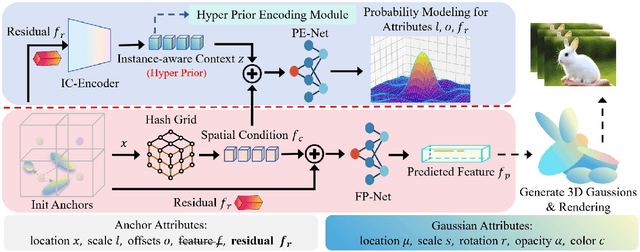
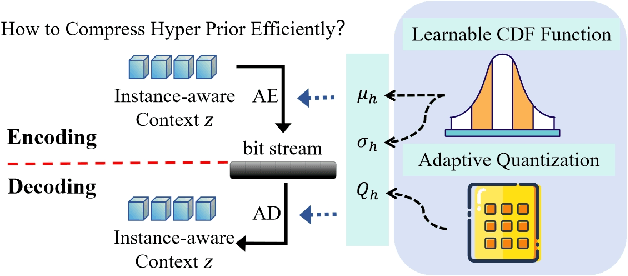
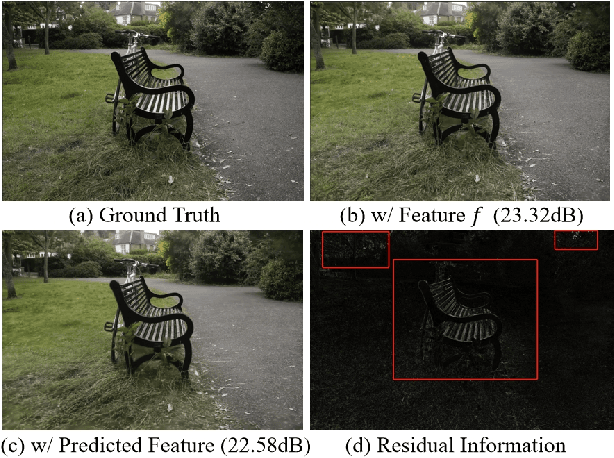

Abstract:Recently, 3D Gaussian Spatting (3DGS) has gained widespread attention in Novel View Synthesis (NVS) due to the remarkable real-time rendering performance. However, the substantial cost of storage and transmission of vanilla 3DGS hinders its further application (hundreds of megabytes or even gigabytes for a single scene). Motivated by the achievements of prediction in video compression, we introduce the prediction technique into the anchor-based Gaussian representation to effectively reduce the bit rate. Specifically, we propose a spatial condition-based prediction module to utilize the grid-captured scene information for prediction, with a residual compensation strategy designed to learn the missing fine-grained information. Besides, to further compress the residual, we propose an instance-aware hyper prior, developing a structure-aware and instance-aware entropy model. Extensive experiments demonstrate the effectiveness of our prediction-based compression framework and each technical component. Even compared with SOTA compression method, our framework still achieves a bit rate savings of 24.42 percent. Code is to be released!
Swift4D:Adaptive divide-and-conquer Gaussian Splatting for compact and efficient reconstruction of dynamic scene
Mar 16, 2025


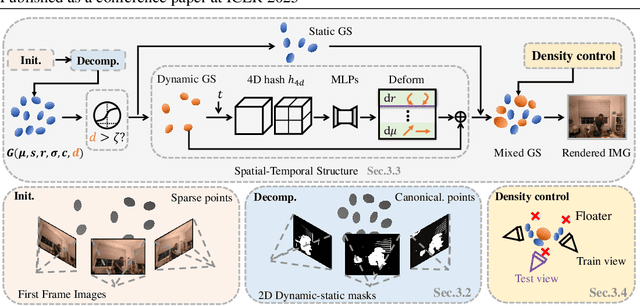
Abstract:Novel view synthesis has long been a practical but challenging task, although the introduction of numerous methods to solve this problem, even combining advanced representations like 3D Gaussian Splatting, they still struggle to recover high-quality results and often consume too much storage memory and training time. In this paper we propose Swift4D, a divide-and-conquer 3D Gaussian Splatting method that can handle static and dynamic primitives separately, achieving a good trade-off between rendering quality and efficiency, motivated by the fact that most of the scene is the static primitive and does not require additional dynamic properties. Concretely, we focus on modeling dynamic transformations only for the dynamic primitives which benefits both efficiency and quality. We first employ a learnable decomposition strategy to separate the primitives, which relies on an additional parameter to classify primitives as static or dynamic. For the dynamic primitives, we employ a compact multi-resolution 4D Hash mapper to transform these primitives from canonical space into deformation space at each timestamp, and then mix the static and dynamic primitives to produce the final output. This divide-and-conquer method facilitates efficient training and reduces storage redundancy. Our method not only achieves state-of-the-art rendering quality while being 20X faster in training than previous SOTA methods with a minimum storage requirement of only 30MB on real-world datasets. Code is available at https://github.com/WuJH2001/swift4d.
CL-MVSNet: Unsupervised Multi-view Stereo with Dual-level Contrastive Learning
Mar 11, 2025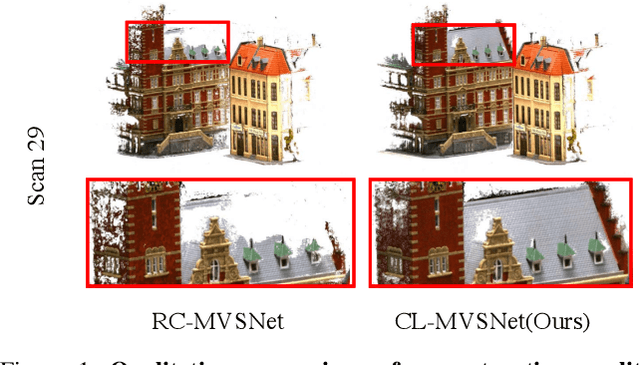
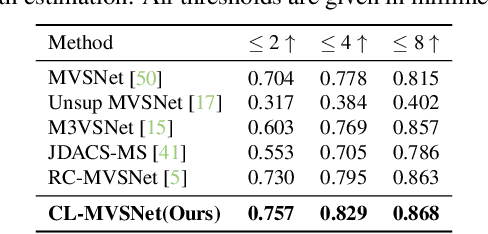
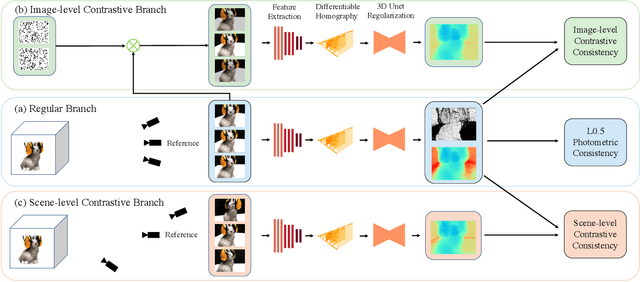
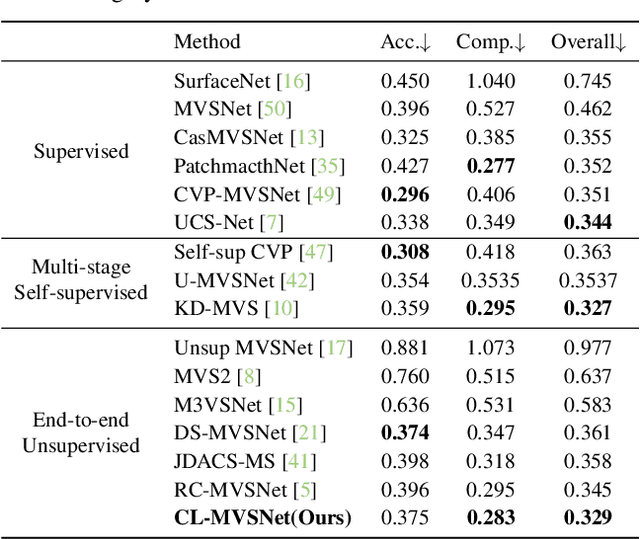
Abstract:Unsupervised Multi-View Stereo (MVS) methods have achieved promising progress recently. However, previous methods primarily depend on the photometric consistency assumption, which may suffer from two limitations: indistinguishable regions and view-dependent effects, e.g., low-textured areas and reflections. To address these issues, in this paper, we propose a new dual-level contrastive learning approach, named CL-MVSNet. Specifically, our model integrates two contrastive branches into an unsupervised MVS framework to construct additional supervisory signals. On the one hand, we present an image-level contrastive branch to guide the model to acquire more context awareness, thus leading to more complete depth estimation in indistinguishable regions. On the other hand, we exploit a scene-level contrastive branch to boost the representation ability, improving robustness to view-dependent effects. Moreover, to recover more accurate 3D geometry, we introduce an L0.5 photometric consistency loss, which encourages the model to focus more on accurate points while mitigating the gradient penalty of undesirable ones. Extensive experiments on DTU and Tanks&Temples benchmarks demonstrate that our approach achieves state-of-the-art performance among all end-to-end unsupervised MVS frameworks and outperforms its supervised counterpart by a considerable margin without fine-tuning.
 Add to Chrome
Add to Chrome Add to Firefox
Add to Firefox Add to Edge
Add to Edge